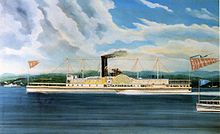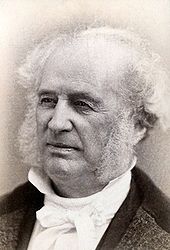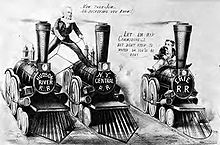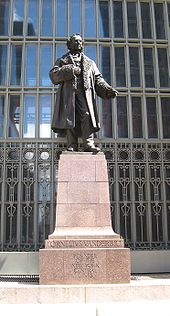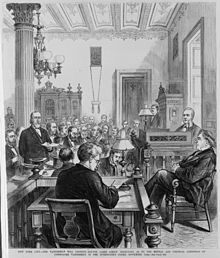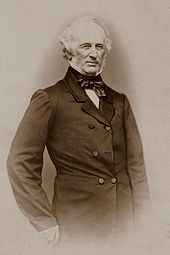- Cornelius Vanderbilt
-
For other people named Cornelius Vanderbilt, see Cornelius Vanderbilt (disambiguation).
Cornelius Vanderbilt 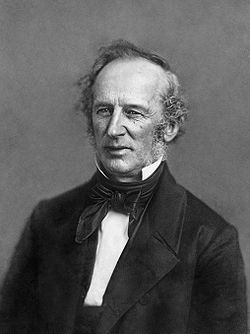
Born May 27, 1794
Staten Island, New York, U.S.Died January 4, 1877 (aged 82)
New York, New York, U.S.Occupation Entrepreneur Net worth USD $105 million at the time of his death (approximately 1/87th of US GNP)[1] Spouse Sophia Johnson (1795–1868)
Frank Armstrong Crawford (1839–1885) m. 1869Children Phebe Jane (Vanderbilt) Cross
Ethelinda (Vanderbilt) Allen
Eliza (Vanderbilt) Osgood
William Henry Vanderbilt
Emily Almira (Vanderbilt) Thorn
Sophia Johnson (Vanderbilt) Torrance
Maria Louisa (Vanderbilt) Clark Niven
Frances Lavinia Vanderbilt
Cornelius Jeremiah Vanderbilt
George Washington Vanderbilt 1832–1836
Mary Alicia (Vanderbilt) LaBau Berger
Catherine Juliette (Vanderbilt) Barker LaFitte
George Washington VanderbiltParents Cornelius Vanderbilt
Phebe HandSignature 
Cornelius Vanderbilt (May 27, 1794 – January 4, 1877), also known by the sobriquet Commodore,[2] was an American entrepreneur who built his wealth in shipping and railroads. He was also the patriarch of the Vanderbilt family and one of the richest Americans in history. He provided the initial gift to found Vanderbilt University, which is named in his honor.
Contents
Ancestry
Cornelius Vanderbilt's great-great-grandfather, Jan Aertson or Aertszoon, was a Dutch farmer from the village of De Bilt in Utrecht, Netherlands, who emigrated to New York as an indentured servant in 1650. The Dutch van der ("of the"/"from") was eventually added to Aertson's village name to create "van der Bilt" ("from De Bilt"), which was eventually condensed to Vanderbilt.[3]
Early years
Born in Staten Island, New York, Vanderbilt began working on his father's ferry in New York harbor as a boy, quitting school at the age of 11. At the age of 16 Vanderbilt decided to start his own ferry service. According to one version of events, he borrowed $100 from his mother to purchase a periauger (a shallow draft, two masted sailing vessel). However, according to the version of the first published account of his life, published in the magazine Scientific American in 1853, the periauger belonged to his father and he received half the profit. He began his business by ferrying freight and passengers between Staten Island and Manhattan.
On December 19, 1813, Vanderbilt married his first cousin, Sophia Johnson (1795–1868), daughter of his aunt Elizabeth Hand Johnson. They moved into a boarding house on Broad Street in Manhattan. He and his wife eventually had 13 children, one of whom died in childhood.[4] In addition to running his ferry, Vanderbilt bought his brother-in-law John De Forest's schooner Charlotte, and traded in food and merchandise, in partnership with his father and others. But on November 24, 1817, a ferry entrepreneur named Thomas Gibbons asked Vanderbilt to captain his steamboat between New Jersey and New York. Though Vanderbilt kept his own businesses running, he became Gibbons's business manager.[5]
When Vanderbilt entered his new position, Gibbons was fighting against a monopoly on steamboats in New York waters, granted by the New York legislature to the politically influential patrician, Robert Livingston, and steamboat designer Robert Fulton. Though both Livingston and Fulton had died by the time Vanderbilt went to work for Gibbons, the monopoly continued in the hands of Livingston's heirs, who had granted a license to Aaron Ogden to run a ferry between New York and New Jersey. Gibbons launched his steamboat venture because of a personal dispute with Ogden, whom he hoped to bankrupt. To accomplish this, he undercut prices, and also brought a landmark legal case – Gibbons v. Ogden – to the United States Supreme Court to overturn the monopoly.[6]
Working for Gibbons, Vanderbilt learned to operate a large and complicated business. He moved to New Brunswick, New Jersey, a stop on Gibbons's line between New York and Philadelphia, where his wife Sophia operated a very profitable inn, using the proceeds to feed, clothe, and educate the children. Vanderbilt also proved a quick study in legal matters, representing Gibbons in meetings with lawyers. He also went to Washington, D.C., to hire Daniel Webster to argue the case before the Supreme Court. Vanderbilt appealed his own case against the monopoly to the Supreme Court, which was next on the docket after Gibbons v. Ogden. The Court never heard Vanderbilt's case, because on March 2, 1824, it ruled in Gibbons's favor, saying that states had no power to interfere with interstate commerce. The case is still considered a landmark ruling, and is considered the basis for much of the prosperity the United States later enjoyed.[7]
Steamboat entrepreneur
After Thomas Gibbons died in 1826, Vanderbilt worked for Gibbons' son William until 1829. Though he had always run his own businesses on the side, he now worked entirely for himself. Step by step, he started lines between New York and the surrounding region. First he took over Gibbons' ferry to New Jersey, then switched to western Long Island Sound. In 1831, he took over his brother Jacob's line to Peekskill, New York, on the lower Hudson River. That year he faced opposition by a steamboat operated by Daniel Drew, who forced Vanderbilt to buy him out. Impressed, Vanderbilt became a secret partner with Drew for the next thirty years, so that the two men would have an incentive to avoid competing with each other.[8]
On November 8, 1833, Vanderbilt was nearly killed in the Hightstown rail accident on the Camden and Amboy Railroad in New Jersey. Also on the train was former president John Quincy Adams.[9]
In 1834, Vanderbilt competed on the Hudson River against a steamboat monopoly between New York and Albany. Using the name "The People's Line," he used the populist language associated with Democratic president Andrew Jackson to get popular support for his business. At the end of the year, the monopoly paid him a large amount to stop competing, and he switched his operations to Long Island Sound.[10]
During the 1830s, textile mills were built in large numbers in New England as the United States experienced an industrial revolution. Some of the first railroads in the United States were built from Boston to Long Island Sound, to connect with steamboats that ran to New York. By the end of the decade, Vanderbilt dominated the steamboat business on the Sound, and began to take over the management of the connecting railroads. In the 1840s, he launched a campaign to take over the most attractive of these lines, the New York, Providence and Boston Railroad, popularly known as the Stonington. By cutting fares on competing lines, Vanderbilt drove down the Stonington stock price, and took over the presidency of the company in 1847, the first of the many railroads he would head.[11]
During these years, Vanderbilt also operated many other businesses. He bought large amounts of real estate in Manhattan and Staten Island, and took over the Staten Island Ferry in 1838. It was in the 1830s when he was first referred to as "commodore," then the highest rank in the United States Navy. A common nickname for important steamboat entrepreneurs, it stuck to Vanderbilt alone by the end of the 1840s.[12]
Oceangoing steamship lines
When the California gold rush began in 1849, Vanderbilt switched from regional steamboat lines to ocean-going steamships. Many of the migrants to California, and almost all of the gold returning to the East Coast, went by steamship to Panama, where mule trains and canoes provided transportation across the isthmus. (The Panama Railroad was soon built to provide a faster crossing.) Vanderbilt proposed a canal across Nicaragua, which was closer to the United States and was spanned most of the way across by Lake Nicaragua and the San Juan River. In the end, he could not attract enough investment to build the canal, but he did start a steamship line to Nicaragua, and founded the Accessory Transit Company to carry passengers across Nicaragua by steamboat on the lake and river, with a 12-mile carriage road between the Pacific port of San Juan del Sur and Virgin Bay on Lake Nicaragua.[13]
In 1852, a dispute with Joseph L. White, a partner in the Accessory Transit Company, led to a battle in which Vanderbilt forced the company to buy his ships for an inflated price. In early 1853, he took his family on a grand tour of Europe in his steamship yacht, the North Star. While he was away, White conspired with Charles Morgan, Vanderbilt's erstwhile ally, to betray him, and deny him money he was owed by the Accessory Transit Company. When Vanderbilt returned from Europe, he retaliated with a rival line to California, cutting prices until he forced Morgan and White to pay him off. He then turned to transatlantic steamship lines, running in opposition to the heavily subsidized Collins Line, headed by Edward K. Collins. Vanderbilt eventually drove the Collins Line into extinction.[14] During the 1850s, he also bought control of a major shipyard and the Allaire Iron Works, a leading manufacturer of marine steam engines, in Manhattan.[15]
In November 1855, Vanderbilt began to buy control of Accessory Transit once again. That same year, the military adventurer, William Walker, took control of Nicaragua. Edmund Randolph, a close friend of Walker, coerced the Accessory Transit's San Francisco agent, Cornelius K. Garrison, into opposing Vanderbilt. Randolph convinced Walker to annul the charter of the Accessory Transit Company, and give the transit rights and company steamboats to him; Randolph then sold them to Garrison. Garrison brought Charles Morgan in New York into the plan. Vanderbilt took control of the company just before these developments were announced. When he tried to convince the U.S. and British governments to help restore the company to its rights and property, they refused. So he negotiated with Costa Rica, which (along with the other Central American republics) had declared war on Walker. Vanderbilt sent a man to Costa Rica who led a raid that captured the steamboats on the San Juan River, cutting Walker off from his reinforcements from the United States. Walker was forced to give up, and was conducted out of the country by a U.S. Navy officer. But the new Nicaraguan government refused to allow Vanderbilt to restart the transit business, so he started a line by way of Panama, eventually constructing a monopoly on the California steamship business.[16]
American Civil War
When the American Civil War began in 1861, Vanderbilt attempted to donate his largest steamship, the Vanderbilt, to the Union navy. Secretary of the Navy Gideon Welles refused it, thinking its operation and maintenance too expensive for what he expected to be a short war. Vanderbilt had little choice but to lease it to the War Department, at prices set by ship brokers. When the Confederate ironclad Virginia (popularly known in the North as the Merrimack) wrought havoc with the Union blockading squadron at Hampton Roads, Virginia, Secretary of War Edwin Stanton and President Abraham Lincoln called on Vanderbilt for help. This time he succeeded in donating the Vanderbilt to the Union navy, equipping it with a ram and staffing it with handpicked officers. It helped bottle up the Virginia, after which Vanderbilt converted it into a cruiser to hunt for the Confederate commerce raider Alabama, captained by Raphael Semmes. Vanderbilt also outfitted a major expedition to New Orleans. But he suffered a personal loss when his youngest and favorite son and heir apparent, George Washington Vanderbilt, a graduate of the United States Military Academy, fell ill and died without ever seeing combat.[17]
Railroad empire
New York and Harlem Railroad
Though Vanderbilt had relinquished his presidency of the Stonington Railroad during the California gold rush, he took an interest in several railroads during the 1850s, serving on the boards of directors of the Erie Railway, the New Jersey Central, the New Haven and Hartford, and the New York and Harlem (popularly known as the Harlem). In 1863, Vanderbilt took control of the Harlem in a famous stockmarket corner, and was elected its president. He later explained that he wanted to show that he could take this railroad, which was generally considered worthless, and make it valuable. It had a key advantage: it was the only steam railroad to enter the center of Manhattan, running down 4th Avenue (later Park Avenue) to a station on 26th Street, where it connected with a horse-drawn streetcar line. From Manhattan it ran up to Chatham Four Corners, New York, where it had a connection to the railroads running east and west.[18]
Vanderbilt brought his son William Henry Vanderbilt in as vice-president of the Harlem. William had had a nervous breakdown early in life, and his father had sent him to a farm on Staten Island. But he proved himself a good businessman, and eventually became the head of the Staten Island Railway. Though the Commodore had once scorned him, he was impressed by William's success, and eventually made him operational manager of all his railroad lines. In 1864, the Commodore sold his last ships, concentrating on railroads.[19]
New York Central and Hudson River Railroad
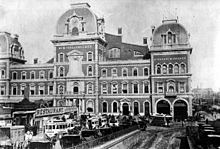 Looking out the north end of the Murray Hill Tunnel towards the station in 1880; note the labels for the New York, Harlem and New York, and New Haven Railroads; the New York Central and Hudson River was off to the left. The two larger portals on the right allowed some horse-drawn trains to continue further downtown.
Looking out the north end of the Murray Hill Tunnel towards the station in 1880; note the labels for the New York, Harlem and New York, and New Haven Railroads; the New York Central and Hudson River was off to the left. The two larger portals on the right allowed some horse-drawn trains to continue further downtown.
Once in charge of the Harlem, Vanderbilt encountered conflicts with connecting lines. In each case, the strife ended in a battle that Vanderbilt won. He bought control of the Hudson River Railroad in 1864, the New York Central Railroad in 1867, and the Lake Shore and Michigan Southern Railway in 1869. He later bought the Canada Southern as well. In 1870, he consolidated two of his key lines into the New York Central and Hudson River Railroad, one of the first giant corporations in American history.[20]
Grand Central Depot
Main article: Grand Central TerminalIn 1869, he directed the Harlem to begin construction of the Grand Central Depot on 42nd Street in Manhattan. It was finished in 1871, and served as his lines' terminus in New York. He sank the tracks on 4th Avenue in a cut that later became a tunnel, and 4th Avenue became Park Avenue. The depot was replaced by Grand Central Terminal in 1913.[20]
Rivalry with Jay Gould
In 1868, Vanderbilt fell into a dispute with Daniel Drew, now treasurer of the Erie Railway. To get revenge, he tried to corner Erie stock, which led to the so-called Erie War. This brought him into direct conflict with Jay Gould and James Fisk Jr, who had just joined Drew on the Erie board. They defeated the corner by issuing "watered stock" in defiance of state law, which restricted the number of shares a company could issue. But Gould bribed the legislature to legalize the new stock. Vanderbilt used the leverage of a lawsuit to get his losses back, but he and Gould became public enemies.
Gould never got the better of Vanderbilt in any other important business matter, but he often embarrassed Vanderbilt, who uncharacteristically lashed out at Gould in public. By contrast, Vanderbilt befriended his other foes after their fights ended, including Drew and Cornelius Garrison.
Death and legacy
Following his wife's death in 1868, Vanderbilt went to Canada where, on August 21, 1869, he married a cousin from Mobile, Alabama, named Frank Armstrong Crawford.[21] Crawford was 43 years younger than her husband. Crawford's cousin's husband, Holland McTyeire, convinced Vanderbilt to endow what would become Vanderbilt University, named in his honor. Vanderbilt gave $1 million, the largest charitable gift in American history to that date. He also bought a church for $50,000 for his second wife's congregation, the Church of the Strangers. He also donated to churches around New York, including a gift to the Moravian Church on Staten Island of 8½ acres (34,000 m2) for a cemetery in which he was later buried.
Cornelius Vanderbilt died on January 4, 1877, at his residence, No. 10 Washington Place, after having been confined to his rooms for about eight months. The immediate cause of his death was exhaustion, brought on by long suffering from a complication of chronic disorders.[22] At the time of his death, aged 82, his fortune was estimated at $100 million. In his will, he left 95% of his $100 million estate to his son William and to William's four sons ($5,000,000 (approx. $99,000,000 in 2008 USD) to Cornelius Vanderbilt II, and $2 million apiece (approx. $39,600,000 in 2008 USD) to William Kissam Vanderbilt, Frederick Vanderbilt, and George Washington Vanderbilt II). The Commodore stated that he believed William Henry was the only heir capable of maintaining the business empire.
He willed amounts ranging from $250,000 (approximate $4,950,000 in 2008 USD) to $500,000 ($9,920,000 in 2008 USD) to each of his eight daughters. His wife received US$500,000, their New York City home, and 2,000 shares of common stock in New York Central Railroad. To his younger surviving son, Cornelius Jeremiah Vanderbilt, whom he regarded as a wastrel, he left the income from a $200,000 trust fund. The Commodore had lived in relative modesty considering his nearly unlimited means, splurging only on race horses, leaving his descendants to build the Vanderbilt houses that characterize America's Gilded Age. (It is worth noting that though trivial in comparison to the $90 million+ inherited by William Henry Vanderbilt and his sons, the bequests to his other children made them very wealthy by the standards of 1877 and were not subject to inheritance tax.)
According to "The Wealthy 100" by Michael Klepper and Robert Gunther, Vanderbilt would be worth $143 billion in 2007 dollars, if his total wealth as a share of the nation's GDP in 1877 (the year of his death) were taken and applied in that same proportion in 2007. This would make him the second-wealthiest person in American history, after John D. Rockefeller.[23][24] Another calculation, from 1998, puts him in third place, after Andrew Carnegie.[25]
Vanderbilt's life story has inspired works of fiction, including the ambitious character of Nat Taggart in Ayn Rand's Atlas Shrugged (1957).[26] His family (see below) has done much the same.
Descendants
Main article: Vanderbilt familyCornelius Vanderbilt was buried in the family vault in the Moravian Cemetery at New Dorp on Staten Island. He was later reburied in a tomb in the same cemetery constructed by his son William. Three of his daughters and son, Cornelius Jeremiah Vanderbilt, contested the will on the grounds that their father had was of unsound mind and under the influence of his son William Henry and of spiritualists he consulted on a regular basis. The court battle lasted more than a year and was ultimately won outright by William Henry Vanderbilt, who then increased the bequests to his siblings and paid their legal fees. One of the current-surviving members of the Vanderbilt family is Anderson Cooper, who is a great-great-great-grandson.
Cornelius Jeremiah Vanderbilt, an epileptic, committed suicide in 1882. George Washington Vanderbilt also died without issue, during the Civil War. All of the Vanderbilt multimillionaires descend through oldest son William Henry.
- Children of Cornelius Vanderbilt and Sophia Johnson
- Phoebe Jane (Vanderbilt) Cross (1814–1878)
- Ethelinda (Vanderbilt) Allen (1817–1889)
- Eliza (Vanderbilt) Osgood (1819–1890)
- William Henry Vanderbilt (1821–1885)
- Emily Almira (Vanderbilt) Thorn (1823–1896)
- Sophia Johnson (Vanderbilt) Torrance (1825–1912)
- Maria Louisa (Vanderbilt) Clark Niven (1827–1896)
- Frances Lavinia Vanderbilt (1828–1868)
- Cornelius Jeremiah Vanderbilt (1830–1882)
- George Washington Vanderbilt (1832–1836)
- Mary Alicia (Vanderbilt) LaBau Berger (1834–1902)
- Catherine Juliette (Vanderbilt) Barker LaFitte (1836–1881)
- George Washington Vanderbilt (1839–1864)
Railroads controlled by Vanderbilt
- New York and Harlem Railroad (1863–)
- Hudson River Railroad (1864–)
- New York Central Railroad (1868–)
- Canada Southern Railway (1873–)[27]
- Lake Shore and Michigan Southern Railway (1873?–)
- Michigan Central Railroad (1877–)[28]
- New York, Chicago and St. Louis Railroad (Nickel Plate Road, 1882–)
- West Shore Railroad (1885–)
- Rome, Watertown and Ogdensburg Railroad
- Dunkirk, Allegheny Valley and Pittsburgh Railroad
- Cleveland, Cincinnati, Chicago and St. Louis Railway
- Lake Erie and Western Railroad
- Pittsburgh and Lake Erie Railroad
See also
- Tennessee Celeste Claflin, mistress of Cornelius Vanderbilt in later life
- List of wealthiest historical figures
References
- ^ Klepper, Michael; Gunther, Michael (1996), The Wealthy 100: From Benjamin Franklin to Bill Gates—A Ranking of the Richest Americans, Past and Present, Secaucus, New Jersey: Carol Publishing Group, p. xi, ISBN 9780806518008, OCLC 33818143
- ^ "Commodore Vanderbilt's Life," New York Times, January 5, 1877
- ^ RootsWeb's WorldConnect Project: Blaine's Mega Tree
- ^ Stiles, T.J., The First Tycoon: The Epic Life of Cornelius Vanderbilt (Knopf Publishing, 2009), pages 9–27.
- ^ Stiles, T.J., The First Tycoon: The Epic Life of Cornelius Vanderbilt (Knopf Publishing, 2009), pages 31–35.
- ^ Stiles, T.J., The First Tycoon: The Epic Life of Cornelius Vanderbilt (Knopf Publishing, 2009), pages 37–48.
- ^ Stiles, T.J., The First Tycoon: The Epic Life of Cornelius Vanderbilt (Knopf Publishing, 2009), pages 47–67.
- ^ Stiles, T.J., The First Tycoon: The Epic Life of Cornelius Vanderbilt (Knopf Publishing, 2009), pages 72–72, 84–87.
- ^ Stiles, T.J., The First Tycoon: The Epic Life of Cornelius Vanderbilt (Knopf Publishing, 2009), pages 90–91.
- ^ Stiles, T.J., The First Tycoon: The Epic Life of Cornelius Vanderbilt (Knopf Publishing, 2009), pages 99–104.
- ^ Stiles, T.J., The First Tycoon: The Epic Life of Cornelius Vanderbilt (Knopf Publishing, 2009), pages 119–146.
- ^ Stiles, T.J., The First Tycoon: The Epic Life of Cornelius Vanderbilt (Knopf Publishing, 2009), pages 124–127.
- ^ Stiles, T.J., The First Tycoon: The Epic Life of Cornelius Vanderbilt (Knopf Publishing, 2009), pages 174–205.
- ^ Schweikart, Larry, and Lynne Pierson Doti. 2010. American entrepreneur: the fascinating stories of the people who defined business in the United States. New York: American Management Association, pages 43–45
- ^ Stiles, T.J., The First Tycoon: The Epic Life of Cornelius Vanderbilt (Knopf Publishing, 2009), pages 217–264.
- ^ Stiles, T.J., The First Tycoon: The Epic Life of Cornelius Vanderbilt (Knopf Publishing, 2009), pages 268–327.
- ^ Stiles, T.J., The First Tycoon: The Epic Life of Cornelius Vanderbilt (Knopf Publishing, 2009), pages 341–364.
- ^ Stiles, T.J., The First Tycoon: The Epic Life of Cornelius Vanderbilt (Knopf Publishing, 2009), pages 365–386.
- ^ Stiles, T.J., The First Tycoon: The Epic Life of Cornelius Vanderbilt (Knopf Publishing, 2009), pages 387–390.
- ^ a b Stiles, T.J., The First Tycoon: The Epic Life of Cornelius Vanderbilt (Knopf Publishing, 2009), pages 391–442, 474–520.
- ^ Knight, Lucian Lamar (1908). Reminiscences of famous Georgians: embracing episodes and incidents in the lives of the great men of the state, Volume 2. New York, New York: Franklin-Turner. p. 123. http://books.google.com/books?id=IdgDAAAAYAAJ&lpg=PA122&ots=A_hBM7_6BF&dq=%22Frank%20Armstrong%20Crawford%22&pg=PA123#v=onepage&q=%22Frank%20Armstrong%20Crawford%22&f=false.
- ^ http://query.nytimes.com/mem/archive-free/pdf?res=F30B13F6385E137B93C7A9178AD85F438784F9
- ^ Jackson, Tom; Evanchik, et al., Monica (2007-07-15). "The Wealthiest Americans Ever". The New York Times. http://www.nytimes.com/ref/business/20070715_GILDED_GRAPHIC.html. Retrieved 2007-07-15.
- ^ Fortune Magazine's "richest Americans". Fortune estimated his wealth at death at $105,000,000, or 1/87 of the nation's GDP.
- ^ Michael Klepper, Robert Gunter, Jeanette Baik, Linda Barth, and Christine Gibson, "The American Heritage 40; A ranking of the forty wealthiest Americans of all time (Surprise: Only three of them are alive today)". American Heritage, Volume 49, Issue 6 (October 1998).
- ^ Robert Tracinski,"The Historic Significance of Atlas Shrugged", Real Clear Politics, Oct. 9, 2007 (accessed Nov. 7, 2009) [1]
- ^ http://user.mc.net/~louisvw/depot/grossisle/gross.htm
- ^ http://www.michiganrailroads.com/RRHX/Stories/JacksonEvolution.htm
that should be deleted.
Further reading
- Burton W. Folsom, Jr. The Myth of the Robber Barons, Young America.
- Mathew Josephson. The Robber Barons (1934), Harcourt Brace Jovanovich. ISBN 0-15-676790-2
- Kurt Schlichting. "Grand Central Terminal" (2001) The Johns Hopkins University Press. ISBN 0-8018-6510-7
- Robert Sobel. The Big Board: A History of the New York Stock Market (1965), reprinted Beard Books (May 2000) ISBN 1-893122-66-2
- T.J. Stiles. The First Tycoon: The Epic Life of Cornelius Vanderbilt (2009), New York: Knopf. ISBN 0375415424
Vanderbilt University Schools and colleges Undergraduate: Blair School of Music • College of Arts and Science • Peabody College • School of Engineering
Graduate: Divinity School • Graduate School • Law School • Owen Graduate School of Management • School of Medicine • School of NursingChancellors People Cornelius Vanderbilt • Holland McTyeire • Martha Rivers Ingram • Southern Agrarians • Vanderbilt alumni • Vanderbilt Commodores • Spirit of Gold • Greek life
Places Dyer Observatory • First Amendment Center • Hawkins Field • Institute for Space and Defense Electronics • Memorial Gymnasium • Nashville • Vanderbilt University Medical Center • Children's Hospital • Vanderbilt University Press • Vanderbilt Stadium
Affiliations Categories:- American businesspeople
- American Civil War industrialists
- American railway entrepreneurs
- 19th-century American railroad executives
- American businesspeople in shipping
- Congressional Gold Medal recipients
- American people of Dutch descent
- People from Staten Island
- Robber barons
- Staten Island Railway
- Vanderbilt family
- Vanderbilt University people
- 1794 births
- 1877 deaths
- Members of the New York Yacht Club
Wikimedia Foundation. 2010.

